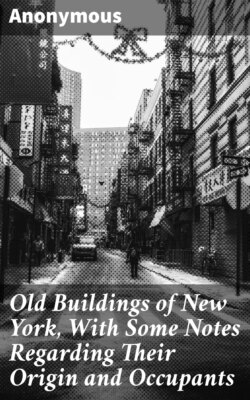Читать книгу Old Buildings of New York, With Some Notes Regarding Their Origin and Occupants - Anonymous - Страница 5
На сайте Литреса книга снята с продажи.
ОглавлениеFraunces’s Tavern
Table of Contents
In the year 1671 Col. Stephen Van Cortlandt built a cottage on the corner of Broad and Pearl (then Queen) streets, to which he brought his bride, Gertrude Schuyler. The house overlooked the waters of the river and bay. In the year 1700 he deeded this property to his son-in-law, Etienne de Lancey, probably wishing to retire to his manor on the Hudson. De Lancey was a French Huguenot of rank who had left his native country on the revocation of the edict of Nantes. He came to New York where he established himself as a merchant. On these premises he built a hip-roofed mansion several stories in height, of small yellow bricks imported from Holland. In dimensions and arrangement it ranked among the best in the colony. The property descended through his son James to his grandson Oliver. This part of the town having by that time become the business quarter in 1757, the house was abandoned as a residence and became the warehouse of De Lancey, Robinson & Co. On January 17, 1762, the building was transferred to Samuel Fraunces, who converted it into a tavern under the name of the “Queen’s Head,” and announced that dinner would be served daily at half-past one. In April, 1768, in the long room, the Chamber of Commerce was inaugurated with John Cruger as president.
On November 25, 1783, the day of the evacuation of the British, a grand banquet was given by Governor Clinton to General Washington and the French minister, Luzerne, and in the evening the “Queen’s Head” and the whole town were illuminated. More than a hundred generals, officers, and distinguished personages attended the banquet and thirteen toasts were drunk commemorative of the occasion. Ten days later Washington here met his generals for the last time. After a slight repast Washington filled his glass and addressed his officers as follows: “With a heart full of love and gratitude, I must now take my leave of you. I most devoutly wish that your latter days may be as prosperous and happy as your former ones have been glorious and honorable.”10 In silence his former companions then took a final farewell of their chief.
This is one of the oldest buildings in the city, as the great fire of 1776 doubtless swept away most of those of earlier date. During the last century the building has gone through various vicissitudes, mostly on the descending scale. A year or two ago the ground floor was occupied by a saloon. Lately the building has been completely restored by the Sons of the Revolution and now presents very nearly its original appearance.
